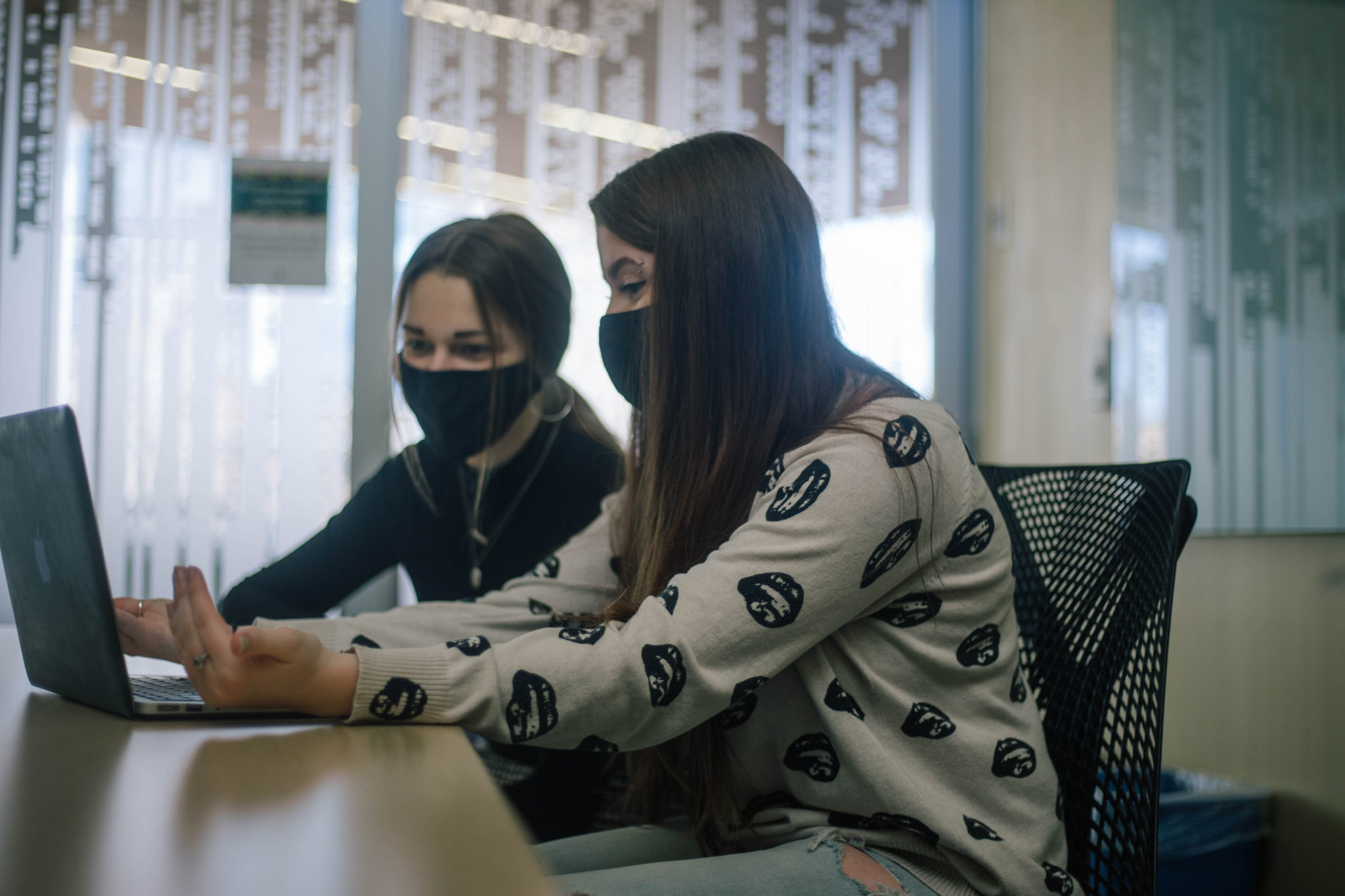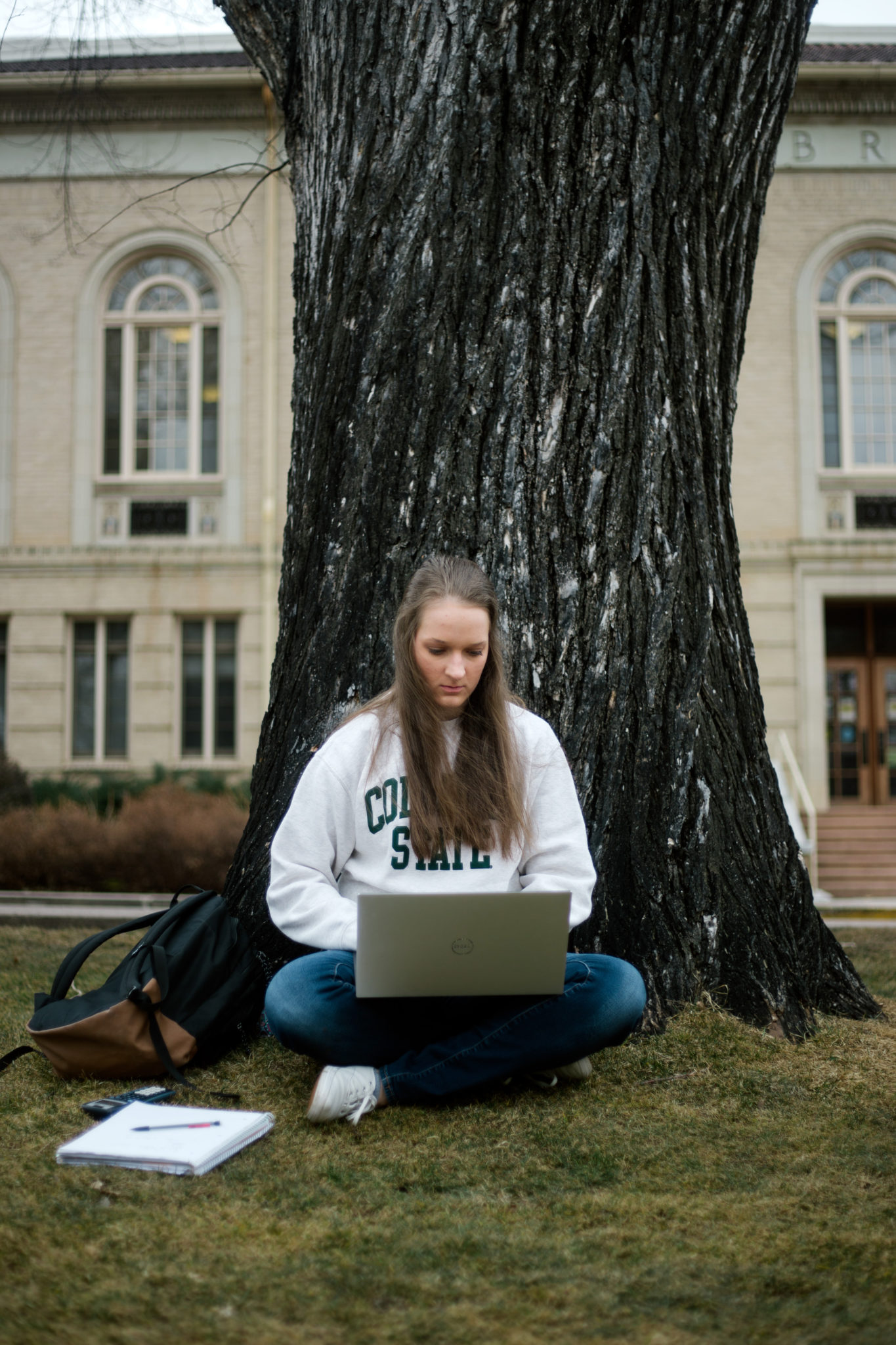By Jessica Cox
Photos by Kellen Bakovich
Illustrations by Billy Babb
Some of the big decisions most soon-to-be college students expect to make include securing financial aid for their education, declaring a major, and choosing a place to live for their first year away from home. Thanks to COVID-19, many incoming students faced an even tougher decision: whether or not to go to college at all.
Following a partial spring semester of emergency remote learning, Colorado State University leadership announced that face-to-face instruction would resume in fall of 2020, with robust COVID-19 precautions in place. Online and hybrid classes replaced in-person learning wherever possible, and all classes went fully virtual following fall break.
University housing was available for students for the 2020-2021 academic year, but unlike previous years, when students were required to live on campus their first year, CSU was more lenient in allowing students to live off campus – and even out of state – to pursue their pandemic-induced online education.
Despite the University welcoming new and returning students with open arms (and masked faces), many incoming Rams wondered, “Is it worth it?”
To go or not to go
“It wasn’t really a question of going to campus or going online, because I knew I didn’t want to do fully online,” said Alex Silverhart, a first-year student in the biomedical sciences program. “It was a matter of going to college or not at all.”
Undergraduate students in the College of Veterinary Medicine and Biomedical Sciences can choose from two majors: biomedical sciences or neuroscience. Silverhart is among the 169 first-year students in the College who committed to coming to campus during the pandemic.

Like many of his peers, Silverhart was looking forward to “the college experience,” which he knew he wasn’t going to get – at least not this year. “I wanted some sort of social interaction with the people in my dorm and my professors,” Silverhart said.
Other incoming students made more unorthodox decisions. Logan Ridenbaugh was living on the Ramstein Air Base in southwestern Germany, where his parents are stationed, and because of the rising rates of COVID-19 infections in the United States, he and his family decided moving to Colorado wasn’t in the cards for the fall semester.
Ridenbaugh considered attending community college and then transferring back into CSU, or working at the local base exchange, but his interest in biomedical sciences led him to the decision to stay enrolled. Enrollment in the biomedical sciences major is capped at 200 students per year, so there are limited opportunities to join the program after the first year of college.
“It would’ve been harder to transfer back into the biomedical sciences program,” Ridenbaugh said. “It made more sense to enroll and come to campus in the spring.”
A little help from your peers
The biomedical sciences and neuroscience programs offer introductory courses to familiarize students with the different concentrations they can choose from, as well as opportunities inside and outside the classroom to enhance learning with the help of faculty and peers.
Developed as part of the launch of the biomedical sciences undergraduate program, VMBS 100, Introduction to Biomedical Sciences Major, is designed to help students succeed in their undergraduate careers. Students meet with faculty through virtual office hours, and they receive guidance from graduate teaching assistants and undergraduate learning assistants, who are juniors and seniors in the same program.
“For lack of a better term, we’re freshman year life coaches,” said Bryce Hill, a senior and undergraduate learning assistant for VMBS 100. “We can give the perspective of someone who’s already been through the program.”
While VMBS 100 was initially intended to be taught in person, all course content was moved online in response to the COVID-19 pandemic, making guidance from mentors even more important.
“Office hours with professors and undergraduate learning assistants have been super helpful because I get to ask them questions one-on-one,” Silverhart said.
“Everyone I’ve met has a ‘grade A’ personality,” said Patrick Graham, a first-year biomedical sciences student. “I don’t know if I would’ve gotten that if I went to school somewhere else.”
Academic adviser Karli Hansen credits the undergraduate learning assistants and graduate teaching assistants with the success of VMBS 100. “They were rock stars,” Hansen said. “They really connect with the students because they’re empathetic and they’re living the same struggles.”

First-year neuroscience students participate in a similar introductory class and a peer-mentoring program in which sophomore, junior, and senior neuroscience students volunteer to mentor first-years.
“Sometimes, it’s intimidating to go to professors and ask for help,” said Madison Blakesley, senior neuroscience student and president of the neuroscience peer-mentoring program. “This is supposed to be an easier connection because these are your peers.”
Blakesley noted that although Fall 2020 was a “weird” semester, peer mentors still seemed to be having a good time making connections and sharing study tips with students. Despite the impacts of COVID-19 and a smaller incoming class, the majority of students signed up or expressed interest in the mentoring program, and the number of mentors has doubled since the program started.
When your classroom is a screen
For those who chose to enroll, the Fall 2020 experience was hardly typical. Adjustments to the college experience were made all over campus, with faculty and staff tweaking (or significantly altering) their curricula to promote safe learning. Many courses, especially lecture-based ones, were offered online. Students had limited opportunities to meet new people.
“A lot of students have been able to make connections with their peers and in the residence halls,” said Elaina Muterspaugh, a senior in anatomy and physiology and undergraduate learning assistant for VMBS 100. “But it’s been harder making those social connections and getting involved around campus.”
Sandra Quackenbush, associate dean for academic and student affairs, recognizes that it was a challenging year for students and faculty.
“We bring our students together from Day 1 with the hope of building community, so they can be successful in these rigorous programs,” Quackenbush said. “But there’s no doubt that this year they struggled with isolation. We’re listening to student feedback and making changes for next year. There’ll be more synchronous learning, but it doesn’t replace direct interaction and active learning in a classroom. We are all missing that and trying to re-create it in our new normal.”
In an academic world full of Zoom meetings and Canvas lectures, many students jumped at the few opportunities for genuine, face-to-face interaction. For example, Silverhart connected with classmates during an in-person Honors seminar. For those who started college remotely, meeting peers face to face was not an option. They did their best to meet people in their online classes, with the hope that a digital friendship could later develop into an in-person one.
With limited opportunities to see new faces, some students turned to extracurricular activities to supplement their social lives. On-campus activities and events are limited to online formats, but many student organizations continued to meet, albeit virtually.
“I’m trying to get involved in as many extracurricular things as I can,” Silverhart said. “I’m taking advantage of what campus has to offer.”
“I’ve been able to find other outlets – I joined Premedica, the pre-health club,” said Veronica Neujahr, a first-year biomedical sciences student. “I like that they’ve had different medical schools and doctors talk about their programs or work over Zoom.”
What’s next?
Everyone would like to return to the “old normal” next year, but it’s too early to know what the first year of college will look like for the Class of 2026. Traditionally, high school seniors are expected to commit to a college by National College Decision Day on May 1. In a sign that the pandemic continues to impact higher education and families, the National Association for College Admission Counseling has suspended that date this year.
Colorado State University is working to move the majority of courses to in-person instruction and full capacity in the fall. To support the return to campus, the University will require COVID-19 vaccinations for faculty, staff, and students. State and county public health protocols will remain in place to ensure the health and wellness of the University community and will impact masking, social distancing, and COVID-19 testing.
“We’ve all gotten through this year, but it wasn’t the ideal environment,” said Sandra Quackenbush, associate dean for academic and student affairs. “We’re looking forward to better times. We’re looking forward to seeing you in person.”
A team approach to mental health
Still, Zoom is not the same as being in the same room, and for some, it can be detrimental. Students learning and socializing in an almost fully digital environment can contribute to the infamous COVID-19-inspired phenomenon, “Zoom fatigue.”
“Some students are already struggling with their mental health,” said Andrew Sustar, a senior in environmental health and an undergraduate learning assistant for VMBS 100. “Zoom just stresses them out more.”
For the upperclassmen serving as mentors, it’s difficult to watch freshmen struggle through less-than-ideal circumstances during the first of what was supposed to be one of “the best four years of your life.”
“It’s really sad, because I remember my first year of college was awesome,” Sustar said. “We’re doing as much as we can to build community, but I feel for the students. I can’t imagine how difficult it is.”
Academic adviser Hansen is “so impressed” with the students who enrolled and their ability to engage in tough conversations.
“More students talked to me about mental health, anxiety, and depression this year than ever before,” Hansen said. “It makes sense, because they were dealing with a huge transition on top of a pandemic. But these students showed up. Even when it was hard, they showed up and they were honest about the experience, and that is something to applaud.”
Mental health became a core part of the curriculum in VMBS 100. They explored self-care, stress management, time management, sleep and exercise, and finding and creating community. Hansen and faculty also helped students make mental health plans and connect with University resources, including individual and group counseling, student case management, and You@CSU, an individualized online tool for well-being and mental health.

‘It’s still college’
It’s not the freshman year anyone asked for. With vaccine developments in the very fields many biomedical sciences and neuroscience students are preparing to enter upon graduation, there’s hope for a little more normalcy in the next few years.
“There’s so much to do at CSU, and I can kind of envision how it would be if COVID didn’t exist,” Silverhart said. “I’ll have more in-person classes and make up for lost time, in a sense. It’ll make those last two or three years that much more special.”
While building the academic foundation of their undergraduate degrees through mostly virtual learning, students are learning how to be flexible and adapt to new circumstances – life skills that can’t really be taught in a classroom, anyway.
“It’s difficult. No one said it was going to be easy, and I don’t think anyone thought it was going to be,” Graham said. “But it’s still college.”
Want to support our students? Click here to give!